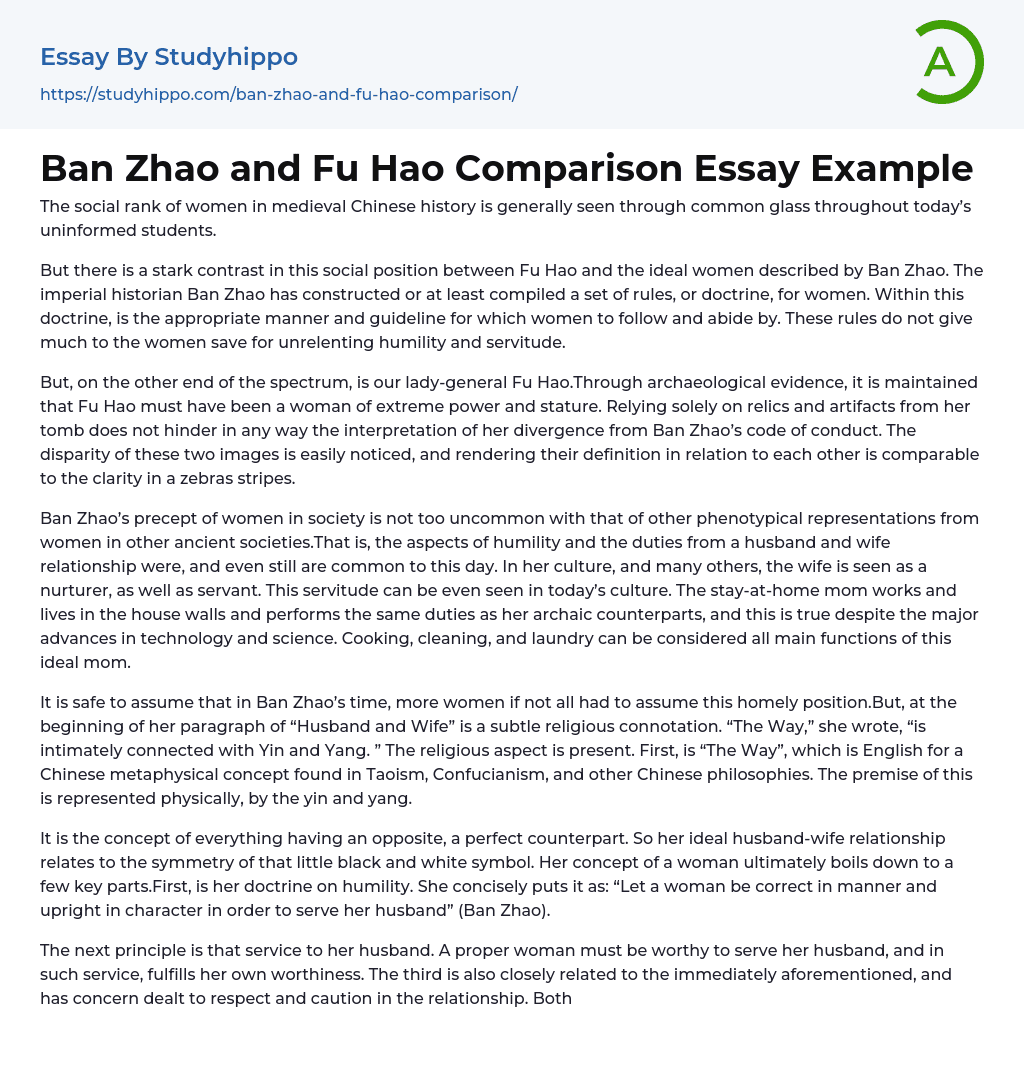The social rank of women in medieval Chinese history is generally seen through common glass throughout today’s uninformed students.
But there is a stark contrast in this social position between Fu Hao and the ideal women described by Ban Zhao. The imperial historian Ban Zhao has constructed or at least compiled a set of rules, or doctrine, for women. Within this doctrine, is the appropriate manner and guideline for which women to follow and abide by. These rules do not give much to the women save for unrelenting humility and servitude.
But, on the other end of the spectrum, is our lady-general Fu Hao.Through archaeological evidence, it is maintained that Fu Hao must have been a woman of extreme power and stature. Relying solely on relics and artifacts from her tomb does not hinder in any
...way the interpretation of her divergence from Ban Zhao’s code of conduct. The disparity of these two images is easily noticed, and rendering their definition in relation to each other is comparable to the clarity in a zebras stripes.
Ban Zhao’s precept of women in society is not too uncommon with that of other phenotypical representations from women in other ancient societies.That is, the aspects of humility and the duties from a husband and wife relationship were, and even still are common to this day. In her culture, and many others, the wife is seen as a nurturer, as well as servant. This servitude can be even seen in today’s culture. The stay-at-home mom works and lives in the house walls and performs the same duties as her archaic counterparts, and this is true despite the major advances i
technology and science. Cooking, cleaning, and laundry can be considered all main functions of this ideal mom.
It is safe to assume that in Ban Zhao’s time, more women if not all had to assume this homely position.But, at the beginning of her paragraph of “Husband and Wife” is a subtle religious connotation. “The Way,” she wrote, “is intimately connected with Yin and Yang. ” The religious aspect is present. First, is “The Way”, which is English for a Chinese metaphysical concept found in Taoism, Confucianism, and other Chinese philosophies. The premise of this is represented physically, by the yin and yang.
It is the concept of everything having an opposite, a perfect counterpart. So her ideal husband-wife relationship relates to the symmetry of that little black and white symbol. Her concept of a woman ultimately boils down to a few key parts.First, is her doctrine on humility. She concisely puts it as: “Let a woman be correct in manner and upright in character in order to serve her husband” (Ban Zhao).
The next principle is that service to her husband. A proper woman must be worthy to serve her husband, and in such service, fulfills her own worthiness. The third is also closely related to the immediately aforementioned, and has concern dealt to respect and caution in the relationship. Both harmonic, and intimate, Ban Zhao’s expected relationship is based upon those two factors.
She then goes as far as to summarize her thoughts in the paragraph titled “Womanly Qualifications”.On the other side of this womanly continuum, is Fu Hao. She may be seen as the yang to Zhao’s yin. In the last Shang capital,
her tomb was excavated and revealed a great deal about her stature as a woman. The article in which her testament is written seems more like an inventory list, rather than a modern eulogy.
She was buried with many luxurious gifts and “contained more than fifteen hundred objects” (NGA). Along with archaic currency and even artifacts attributed to male burials, are oracle texts, giving historians and archaeologists insight into her action in military campaigns.Due to the size and content of her burial site, it is commonly deduced that she was more than a lowly housewife, and the oracle texts clearly state her as a general and even give reference to a specific campaign. Her status as an idol is realized through the construction of a large hall above her tomb that may have been used to continue ritual and memorial services. Conclusively, the position of women as described by Ban Zhao differs greatly from the actual position of Fu Hao.
Hao represents the prodigal woman, being a wealthy general with a great deal of respect and admiration accorded for her. Ban Zhao gives the rules for a common woman that demonstrates proper manner and etiquette for the women of that, and even possibly, our time. ? Works Cited NGA, "More about Excavations at the Tomb of Fu Hao. " Part Two: Bronze Age China 10 Sep 2008 <http://www.
nga. gov/education/chinatp_fu. htm>. Swan, Nancy. "Lessons for a Woman.
" Pan Chao: Foremost Woman Scholar of China (1932) 10 Sep 2008 <http://acc6. its. brooklyn. cuny. edu/~phalsall/texts/banzhao.
html>.
- Bangladesh essays
- China essays
- Hong Kong essays
- India essays
- Japan essays
- Kuala Lumpur essays
- Malaysia essays
- Manila essays
- Pakistan essays
- Philippines essays
- Singapore essays
- Vietnam essays
- Vietnamese essays
- John Locke essays
- 9/11 essays
- A Good Teacher essays
- A Healthy Diet essays
- A Modest Proposal essays
- A&P essays
- Academic Achievement essays
- Achievement essays
- Achieving goals essays
- Admission essays
- Advantages And Disadvantages Of Internet essays
- Alcoholic drinks essays
- Ammonia essays
- Analytical essays
- Ancient Olympic Games essays
- APA essays
- Arabian Peninsula essays
- Argument essays
- Argumentative essays
- Art essays
- Atlantic Ocean essays
- Auto-ethnography essays
- Autobiography essays
- Ballad essays
- Batman essays
- Binge Eating essays
- Black Power Movement essays
- Blogger essays
- Body Mass Index essays
- Book I Want a Wife essays
- Boycott essays
- Breastfeeding essays
- Bulimia Nervosa essays
- Business essays
- Business Process essays
- Canterbury essays
- Carbonate essays




